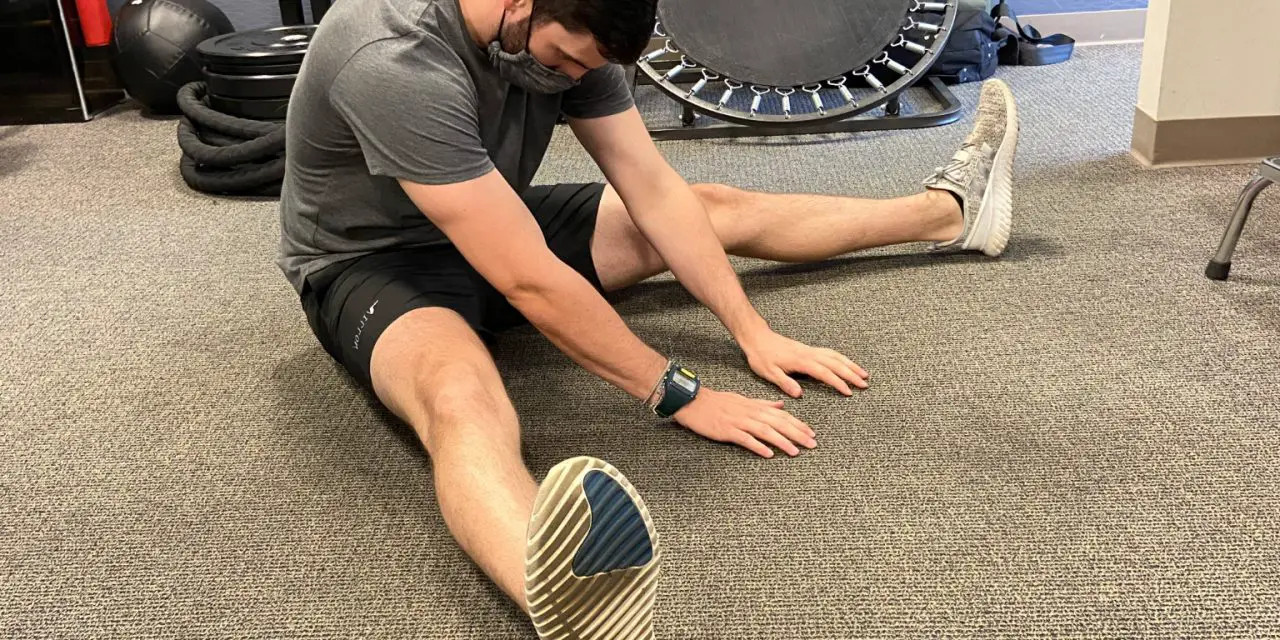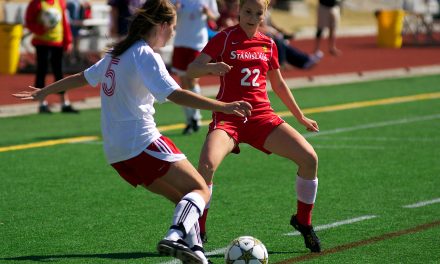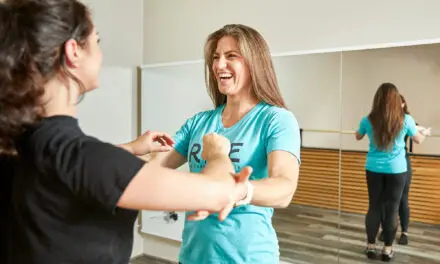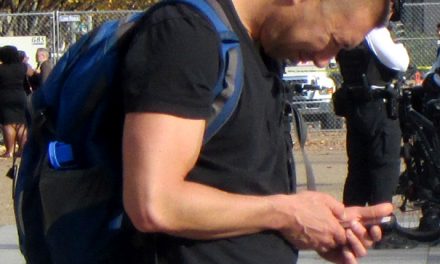Hyperbolic Stretching is a rising star in the world of “next best thing” in fitness programming. The gender-specific program is based on the idea that full-body flexibility can be transformed in four weeks (eight minutes per day!) and that men and women need different stretching techniques to achieve their fitness goals. The program boasts that it is suitable for novices and experts. But is it legit as it sounds?
Generally — albeit without any actual scientific basis — stretching is considered a cornerstone of any good fitness routine. For decades, fitness gurus have preached the value of stretching despite the lack of evidence that it warms muscles up, decreases pain, or improves recovery.
The problem with viewing stretching as a panacea is that it just doesn’t pass muster for anything other than increasing range of motion. Paul Ingraham of PainScience, who took a deep dive into all things stretching, wrote, “Stretching as therapy mostly rides on the coattails of stretching’s indomitable popularity for other purposes, especially the nearly universally accepted idea that flexibility is a pillar of wellness and fitness, on par with strength and endurance.
“Unfortunately, that claim does not hold up to scientific scrutiny. All common ideas about the benefits of stretching have been shot down by research over the last twenty years.”
Enter the new kid on the block: hyperbolic stretching. The brainchild of Alex Larsson, the program’s goal is to teach users a routine that makes a lot of hefty promises.
Larsson is an ex-computer programmer who left his sedentary lifestyle to become an expert in flexibility. According to Larsson, a “total neuro-muscular shutdown in my back, hips, and hamstrings” was the problem. He doesn’t completely connect the dots between this incident and the development of his program. If the number of users he reports are true, the people aren’t concerned about the lack of connection.
The root word in the program title, hyperbole, derives from the Greek word for “excess.” Hyperbolic stretching seems to fit the bill as the program’s main idea is excessive or exaggerated stretching with the ultimate goal of achieving the splits. It’s not just improving range of motion, but having you doing the actual splits.

Photo: Penny Goldberg
How does hyperbolic stretching work?
Broadly, the program claims to provide improved flexibility, muscular relief, core strength, and pelvic floor and hip power. The website doesn’t claim much more but several other reviews with nearly identical information attribute some interesting effects to the program.
Reviewers indicate the program can strengthen muscles, improve flexibility and agility, enhance confidence and self-esteem, and boost energy. Specifically, the program can assist with incontinence, spinal cord issues, and joint pain.
Some boast that users will not only be able to do a full split (without a warm-up!) but also improve performance in the bedroom. The program also claims to stimulate nitric oxide production and the release of human growth hormone.
Not surprisingly, these reviews provide affiliate links to the program. This one seems to be run by Larsson but identifies him as a flexibility and penis enlargement expert and, as such, the target market seems to be no longer the general fitness enthusiast.
The primary targets of the program are the pelvic floor muscles. The “survival reflux” is the theorized reason why many are unable to achieve maximal flexibility. The program purports to turn off this “tension reflux” which allows new limits for flexibility and mobility.
Those with a background in anatomy or physiology who are thinking, “That’s strange, I’ve never heard of the ‘survival reflux’ or ‘tension reflux,’ I think you can safely replace those words with thoughts of reciprocal inhibition to be in the same ballpark.
The five-phase program includes a warm-up series, split test, exercises for week one to four, and flexibility maintenance routine. Larsson offers a 60-day money-back guarantee on the digital program. Buyers are granted instant access to online videos.
The videos are only available to stream. There’s no avenue for downloading or saving the program to your computer so it can only be performed when an internet connection is available. A one-time fee of $27 gets you lifetime access.
Most users seem to have improved flexibility even if they can’t do a full split. One user, Dr. Daniel Lopez of Lakewood, Colorado, notes a decrease in his long-standing low back pain but this didn’t come easily. He said that the program was both difficult and uncomfortable.
Lopez thinks those with lower-body tightness may do better with the program than the average healthy person. “I do think the general public would do well with the product, but I do feel that there is a more specific population that would benefit the most,” he said.
He specifically refers to people who have chronic tight muscles in their legs and hips, like those who feel ‘unusually uncomfortable’ when they attempt to bend forward to touch their toes.
Chris Worfolk, a triathlete and a psychologist from Leeds, U.K., takes a scientific approach to documenting his progress before and after. He does not have affilated links or any affiliation with hyperbolic stretching. Worfolk’s video shows him on Day 1, unable to achieve a full split and then again four weeks later. He marked his distance using furniture in his home so it’s not exact but he seems to have made minimal gains in flexibility.
He continued the program for an additional four weeks and found that though he made some gains, he was still nowhere near a full split. Worfolk makes an excellent point in his video: you should expect to see results from any stretching program after eight weeks if you participate as directed.
In summary, he said that the program seems to have a positive effect on flexibility, but it’s probably not a quick route to the full splits if that is what you’re looking for.
Is hyperbolic stretching legit?
Additional claims from non-official sources include increased energy, improved sexual prowess, the release of human growth hormone, and the production of nitric oxide and human growth hormone. Whether or not this product is legit depends on which specific claim you refer to. There’s plenty of evidence that stretching improves flexibility, so for its main purpose, it’s legit.
Regarding the effect of stretching on pain, the evidence is mostly positive. A 2008 study in Clinical Rehabilitation found that neck pain was decreased by stretching and strengthening and by stretching alone but participants were slightly more likely to do their homework when it was stretching only.
One of the more “out there” claims — that the program increases male virility — also seems to be rooted in science. The program contends it stimulates the production of nitric oxide, which may enhance sexual performance.
It turns out that exercise is a major player in nitric oxide production. This production of nitric oxide is driven by the increasing oxygenation needs of our body tissues. Nitric oxide is a vasodilator which clears the path for increased blood floor and more oxygen where needed.
This includes vasodilation and increased blood flow that creates and sustains an erection and stimulation of the sex organs in women. Thus, using exercise to improve nitric oxide production can play a role in sexual function.
Does hyperbolic stretching improve flexibility?
It’s easy to find evidence that stretching improves flexibility. After all, improved flexibility is the goal of stretching. In a 2016 systematic review and meta-analysis, Medeiros et al. investigated static stretching on hamstring length in healthy young adults. The review concluded that static stretching is effective for improving hamstring flexibility but stopped short of making recommendations for stretching parameters because there was so much variety in the methods used in the studies.
A 2019 systematic review and meta-analysis looked at PNF stretching techniques for hamstring flexibility and found that current best evidence suggests hold-relax and contract-relax stretching are better than nothing when it comes to increasing hamstring flexibility- at least short term.
There was limited evidence to suggest these techniques are better than any other approach long-term. That said, it’s likely that hyperbolic stretching users are seeing immediate effects of their stretching practice, but in the long haul, it may not be anything inherent to the program that creates their result. Instead, it’s the dedicated time spent stretching, not the specific technique, that matters.
If you’re anything like me, efficiency is the key to fitting everything into the day. If you’re a stretching loyalist, I have good news for you. You can use your strength training to do your stretching! Focusing on slow, controlled movement through a full range of motion during weight training can do just as much for muscle length as dedicated stretching time.
And that’s not all. If you get really good at using reciprocal inhibition, you can stretch one side of the joint while you strengthen the other! The muscles on one side of the joint will relax to accommodate the contraction of the muscles on the other side.
Some of my favorite examples of this are: using bilateral shoulder external rotation to stretch pectoralis minor, using a bridge to facilitate hip flexor relaxation through contraction of the glutes, and back to wall scaption to stretch the lats, triceps, and rhomboids. If you’re short on time or just plain like to get in and out of the gym, reciprocal inhibition can be a game-changer when it comes to flexibility.
Does hyperbolic stretching reduce cellulite (for women)?
That’s a hard NO! Cellulite is the product of deep fat deposits that can no longer be constrained by the collagen fibers in our body. This can happen at any age but tends to follow the normal aging process. As we get older, our connective tissue gets weaker, we exercise less, and voila! Cellulite appears!
The good news is that we can do something about it. Strengthening, not stretching, can improve the appearance of cellulite. Improving muscle tone and decreasing overall fat stores is the best path to minimizing the appearance of the dimples on your hips, buttocks, and belly.
Does hyperbolic stretching increase muscle mass?
There’s some evidence that stretching can increase muscle mass but it’s outdated and may not be transferable to humans. A 30-year-old study from the Journal of Applied Physiology tested the latissimus dorsi in quails. Loads ranging from 10% to 35% of the bird’s body weight were attached to their right wing (the left wing was the control) and left there to hold the weight over time (i.e. stretch).
Over the next 28 days, the birds followed a protocol where the weight was increased or they rested. After 28 days, the right-wing muscle mass had increased a whopping 318%. It seems a very famous Mr. Olympia popularized this mostly bird-brained idea.
The theory behind this “stretch to gain mass” thought process seems to be that if you lengthen the tissue that constrains muscle fibers, you will create more space for the muscles to expand. You read that right. Somehow the idea of lengthening the fascia to gain width in muscle fibers was popularized based on these sacrificial lambs…err, birds.
But here’s the best part: the technique described is hardly stretching. It isn’t hard to imagine. If you work your chest (like a bench press) and then lay on a bench with the dumbbells in a maximal stretch position for your chest (think parallel or just past parallel to your body) for a minute, you just might get stronger. The muscle is isometrically working to hold that stretch position just as the bird wings did!
Of course, your body is going to follow the SAID principle (specific adaptations to imposed demands) and increase fiber size! This would also happen if you hold the bottom of a squat (where the quads are longest) or the extended position of a bicep curl. That’s not groundbreaking or the miracle of stretching. That’s basic science.
Does stretching impede strength?
Well, it depends. A systematic review from Medicine and Science in Sports and Exercise examined the effects of stretching on muscle performance and found evidence that short-duration static stretching (30-45 seconds) has no detrimental effect on strength, power, or speed tasks. Conversely, significant decrease of performance was likely to occur with static stretching longer than 60 seconds.
These findings suggest that based on a dose-response effect between stretching and performance, short-duration stretches typical of a pre-exercise routine are unlikely to compromise performance.
More research on how the type of stretching affects performance echoes these results. Investigators examined static stretching, dynamic stretching, and PNF stretching to determine if the type of stretching makes a difference when it comes to performance on power or strength-based tasks. Data from this review revealed that all three types of stretching created small to moderate performance alterations. It suggests a dose-response relationship exists between static stretching and performance as longer holds were associated with more performance deficits.
Conversely, it seems dynamic stretching may improve small to moderate levels of performance when done just before the activity. It may be worthwhile to include this type of warm-up if you just can’t quit stretching.
Does stretching increase human growth hormone (HGH)?
To make this claim, we’d have to be talking about some really intense stretching!
In a landmark study from the University of California Los Angeles, researchers investigated the effect of high and low-intensity exercise on human growth hormone. Healthy volunteers used a cycle-ergometer to perform one-, five-, and 10-minute work at high intensity or low intensity. After low-intensity exercise, HGH didn’t increase significantly whereas after high-intensity work, it was significantly elevated in the circulating blood.
The body of literature related to HGH and exercise is large and rooted in complicated human and exercise physiology, but one thing is clear even to the unscientific eye: to influence hormone secretion through exercise, the work needs to be of sufficient intensity.
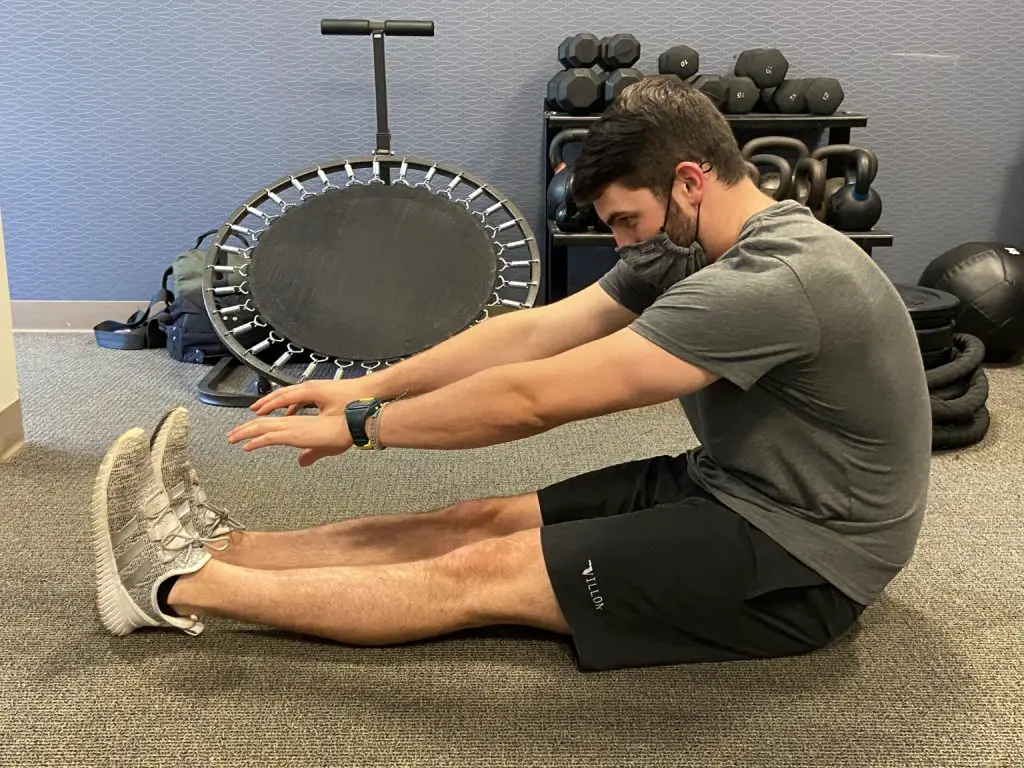
Photo: Penny Goldberg
Does hyperbolic stretching promote fat loss?
Probably not. It’s not impossible to burn fat through stretching but certainly stretching alone isn’t enough. There’s a way that we can make this more sense.
If you add 10 to 15 minutes of stretching to the end of your workout, you would increase the amount of energy your body needs at precisely the point where it’s already burning through fat stores. In the simplest terms, our first resource for energy — regardless of the intensity of the work — is the glycogen storage in the liver. Once that energy source has been exhausted, our bodies shift into fat-burning mode.
For most people, it takes about 30 to 40 minutes of moderate-intensity exercise to deplete glycogen stores and start burning fat as fuel. On average, if you plan to workout for an hour, only the last 20-30 minutes are truly targeting fat loss. Obviously, the harder you work, the faster you burn through glycogen and get to fat-burning mode. Stretching will burn calories, but to say it promotes fat loss is a bit of a…stretch.
Does stretching provide stress or tension relief?
One of the best indirect effects of stretching is the relief of stress and tension. Stretching before bedtime can help improve sleep quality through reduced mental stimulation particularly when attention is paid to breath control.
It’s well-accepted that regular activity keeps us healthy and reduces stress. Stress can look like irritability, worry, insomnia, or anger. These forms of mental stress can cause physical symptoms such as muscle tension, upset stomach, headaches, or pain.
Exercise decreases the secretion of stress hormones. If you can move more to decrease the amount of adrenaline or cortisol in your blood, you can help your body stay out of the “fight-or-flight” response. Better control of these hormones allows you to manage your responses to stressful situations with a clearer mind.
If you’ve seen the film Legally Blonde, you also know that exercise stimulates endorphin production. In the immortal words of Elle Woods, “Exercise gives you endorphins. Endorphins make you happy. Happy people just don’t shoot their husbands, they just don’t.”
Should you do high kicks and full splits without a warmup?
Probably not. Most people don’t do high kicks or full splits on a regular basis. If you wouldn’t test your bench press max without a proper warm-up, you shouldn’t do these moves cold either.
If you perform high kicks and full splits daily, doing it without a warm-up is probably safe. If you don’t warm-up, you’ll benefit from spending time generating an overall body warm-up to enhance muscle flexibility.
Are there any real benefits of hyperbolic stretching?
I think the hyperbolic stretching program likely has some benefits. If your goal is improved flexibility, and not necessarily the splits, I think the program can help. The rest of the benefits touted by the program either have scant evidence to support them or are those that would come with any form of exercise — not just stretching and not necessarily this form of stretching.
Lopez and I mostly agree. When it came to his decision to purchase the program, he said, “I figured with the low price point and the money-back guarantee, I would try it out and see if there was anything to it given my lifelong history of low back pain and tension.”
As a physical therapist, traditional stretching lives in a grey area for me. I think there are some worthwhile benefits, but I have found that if I give patients a program that includes stretching and strengthening, most come back and tell me they only did the stretches. While that’s better than nothing, more benefits come from strength training, so I tend to prioritize that. Once the strength training is done, if there is time left over, why not stretch?

Penny Goldberg, DPT, ATC
Penny Goldberg, DPT, ATC earned her doctorate in Physical Therapy from the University of Saint Augustine and completed a credentialed sports residency at the University of Florida. She is a Board Certified Clinical Specialist in Sports Physical Therapy.
Penny holds a B.S. in Kinesiology and a M.A. in Physical Education from San Diego State University. She has served as an Athletic Trainer at USD, CSUN, and Butler University.
She has presented on Kinesiophobia and differential diagnosis in complicated cases. Penny has published on returning to sports after ACL reconstruction and fear of movement and re-injury.
Outside of the clinic, Penny enjoys traveling, good cooking with great wine, concerts, working out and playing with her dogs.

